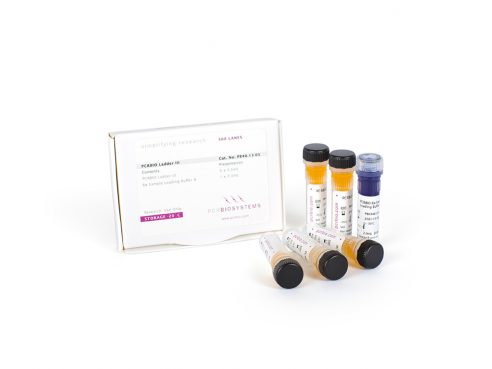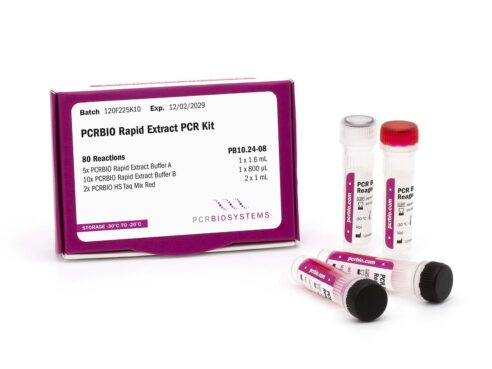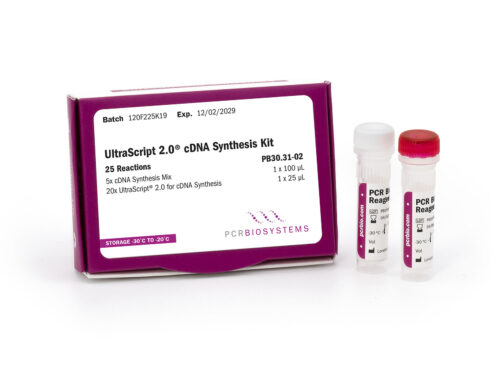PCRBIO Ultra Polymerase & Mixes
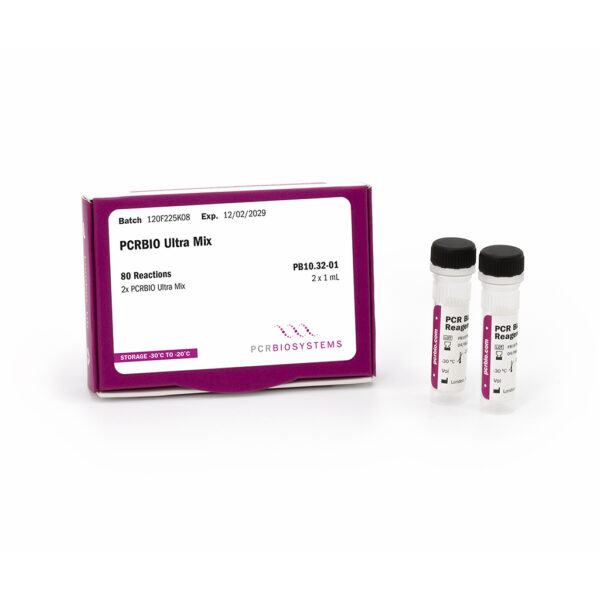
PCRBIO Ultra Polymerase has been engineered for the amplification of extremely difficult templates.
Proprietary modifications that enhance processivity together with advanced buffer chemistry and hot start technology deliver outstanding performance whether your template is GC or AT-rich, low in abundance or contains PCR inhibitors.
PCRBIO Ultra Polymerase is a highly robust enzyme, designed for efficient and reliable amplification of challenging and complex targets, even under difficult conditions such as the presence of inhibitors. The enzyme and buffer system have been developed to give superior PCR performance and higher success rates on a broad range of templates, including complex genomic DNA and targets with a high GC content (up to 80% GC).
Features
- Increased PCR success rates with difficult templates
- Exhibits high tolerance to PCR inhibitors
- Efficient specific amplification from complex templates including GC-rich sequences (up to 80%)
- Antibody-mediated hot start for unrivalled detection of low copy number templates
- Advanced buffer chemistry including Mg and dNTPs
- High yields under standard and fast PCR conditions
- 3 fold higher fidelity than Taq
- Available as a convenient 2x ready mix with the option of a red dye for direct gel loading
Applications
- Difficult PCR – GC and AT-rich DNA
- Low copy template detection
- Crude sample PCR
- Colony PCR
- Long range PCR
- Multiplex PCR
- TA cloning
- Next generation sequencing
PCRBIO Ultra Polymerase exhibits a high tolerance to PCR inhibitors making it the ideal choice for colony and crude sample PCR. PCR products generated are A-tailed and may be cloned into TA cloning vectors. The enzyme is supplied with an optimised buffer containing dNTPs and MgCl2.
Our antibody-mediated hot start formulation prevents the formation of primer dimers and non-specific products, enabling specific and sensitive amplification from low copy number target sequences. For added convenience PCRBIO Ultra Polymerase is also available as a 2x ready mix containing all reaction components except primers and template. PCRBIO Ultra Mix Red contains a preloaded red dye suitable for direct loading and tracking during agarose gel electrophoresis.
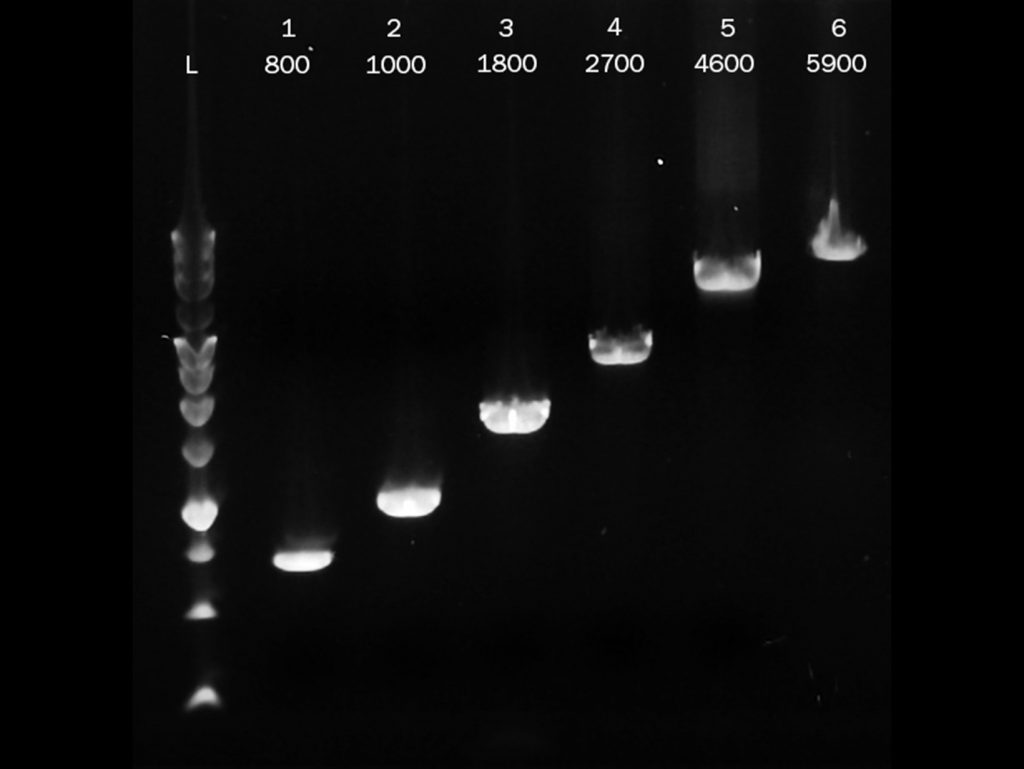
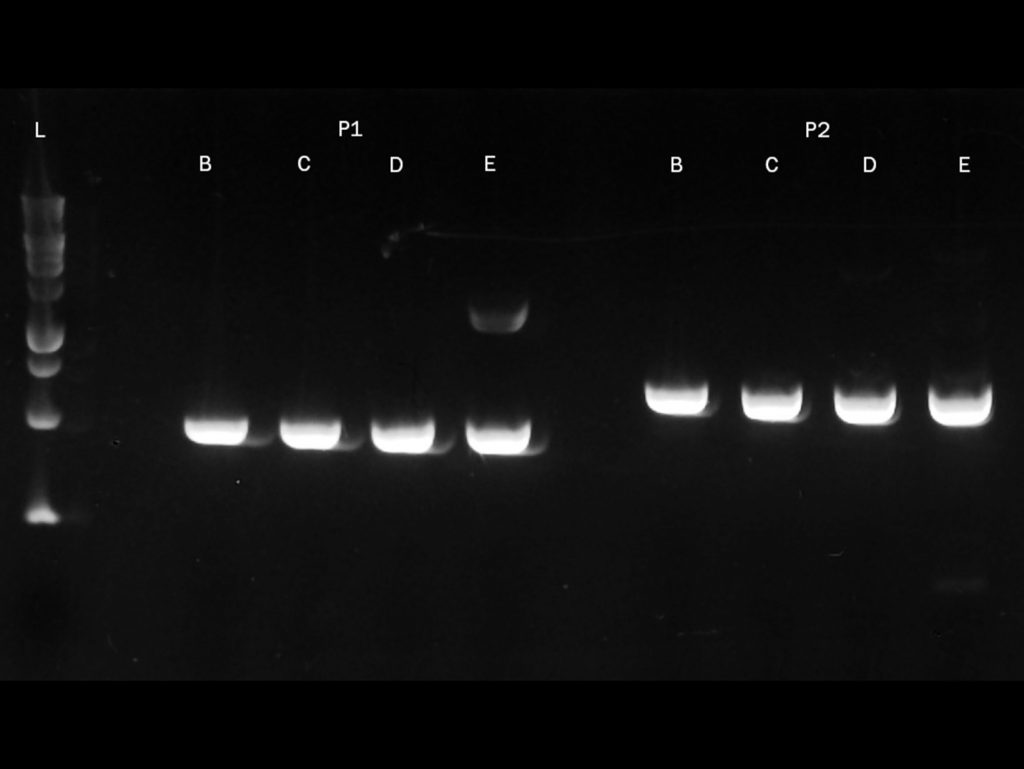
Documents
Product Flyers
Product Manuals
Material Safety Data Sheets
Certificate of Analysis Finder
Specifications
PCRBIO Ultra Polymerase
Component
250 Units
1000 Units
PCRBIO Ultra Polymerase (5u/μl)
1 x 50μL
4 x 50μL
5x PCRBIO Ultra Buffer
2 x 1mL
8 x 1mL
PCRBIO Ultra Mix
Component
80 Reactions
400 Reactions
2x PCRBIO Ultra Mix
2 x 1mL
10 x 1mL
PCRBIO Ultra Mix Red
Component
80 Reactions
400 Reactions
2x PCRBIO Ultra Mix Red
2 x 1mL
10 x 1mL
PCRBIO Ultra Polymerase
Component
PCRBIO Ultra Polymerase (5u/μl)
5x PCRBIO Ultra Buffer
250 Units
1 x 50μL
2 x 1mL
1000 Units
4 x 50μL
8 x 1mL
PCRBIO Ultra Mix
Component
2x PCRBIO Ultra Mix
80 Reactions
2 x 1mL
400 Reactions
10 x 1mL
PCRBIO Ultra Mix Red
Component
2x PCRBIO Ultra Mix Red
80 Reactions
2 x 1mL
400 Reactions
10 x 1mL
Reaction Volume
Storage
50μL
On arrival, products should be stored between -30 and -20 °C. If stored correctly the kit will retain full activity until the indicated expiry date.
Reaction Volume
50μL
Storage
On arrival, products should be stored between -30 and -20 °C. If stored correctly the kit will retain full activity until the indicated expiry date.
FAQs
What is the apparent Mw of the Red Mix dye on agarose gels?
This non-inhibitory dye, added to enable direct gel loading, runs at a similar rate to 200-300 bp DNA fragments on a 1% agarose gel and at 50-100 bp on a 2% agarose gel. You may notice a shift in this apparent molecular weight when running gels of different agarose content.
What is the error rate of PCRBIO Ultra Polymerase?
The enzyme has an error rate of approximately 1 error per 5.0 x 105 nucleotides incorporated.
What is the recommended extension time for PCRBIO Ultra Polymerase?
For amplicons below 5kb, we recommend 15 seconds per kb for amplification from eukaryotic DNA. For longer amplicons, we recommend between 40 and 60 seconds per kb.
Can PCRBIO Ultra Polymerase be used for colony PCR?
Yes. If you’re working from bacterial colonies use a sterile tip to pick a colony and re-suspend into the 50µl PCR reaction. If working from liquid culture add 5µl of overnight culture to the final mix. Follow the general protocol and increase the initial denaturation time to 10 min at 95°C.
Can PCRBIO Ultra Polymerase be used to amplify DNA from blood samples?
Yes. Use 2 µL blood sample to a 50 µL PCR reaction and follow the general protocol. Please note that blood components may inhibit the PCR reaction. Perform a serial dilution of the sample in order to find the optimal template concentration for the PCR amplification.
My results contain a high background of non-specific amplicons or smears. What trouble-shooting suggestions do you have?
If smears are a concern, it’s good practice to ensure they are not an artifact of running agarose gel electrophoresis with sub optimal conditions. Sub optimal conditions can include high voltage or not allowing enough time for the gel to set1.
You may also need to troubleshoot the PCR reaction and consider the suggestions below2.
- Primers should be designed to prevent primer-primer interactions and improve specificity.
- Increase the annealing temperature or conducting an annealing temperature gradient PCR to determine the optimal annealing temperature.
- Reduce the amount of template in the reaction. For high quality DNA, use 1–100 ng genomic DNA or ≤5 ng plasmid/lambda DNA per 50 µL reaction.
- Reduce the number of cycles.
- Reduce the amount of enzyme per reaction.
- Reduce the primer concentration, but not lower than 100 nM of each primer.
- Include DMSO in the reaction to a final concentration of 5%–10%.
1 Koontz, L. Agarose Gel Electrophoresis. Laboratory methods in enzymology : DNA. First edition. edn, Vol. 529 35-45 (2013).
2 Lorenz, T. C. Polymerase chain reaction: basic protocol plus troubleshooting and optimization strategies. J Vis Exp, e3998, doi:10.3791/3998 (2012).
My results show a very low yield. What trouble-shooting suggestions do you have?
You may want to consider the suggestions below and also refer to the literature1.
- Optimise the annealing temperature in an annealing temperature gradient PCR.
- Increase the amount of template in the reaction.
- Increase the number of cycles.
- Increase the amount of enzyme per reaction.
- Increase the primer concentration, but do not exceed 1 µM of each primer.
- Try a fresh dNTP solution.
- Optimise the MgCl2
1 Lorenz, T. C. Polymerase chain reaction: basic protocol plus troubleshooting and optimization strategies. J Vis Exp, e3998, doi:10.3791/3998 (2012).
Can I use PCRBIO Ultra Polymerase if my assay requires a specialized buffer?
The 5x PCRBIO Ultra Buffer supplied with PCRBIO Ultra Polymerase has been developed specifically for this enzyme and we highly recommend using them together. However, PCRBIO Ultra Polymerase should be compatible with any PCR buffer developed for use with wild-type Taq. If you use a customised buffer with PCRBIO Ultra Polymerase, keep in mind reaction parameters such as annealing temperature and concentrations of the enzyme, template, dNTPs and MgCl2, may require optimisation.
PCRBIO Ultra Polymerase is a highly robust enzyme, designed for efficient and reliable amplification of challenging and complex targets, even under difficult conditions such as the presence of inhibitors. The enzyme and buffer system have been developed to give superior PCR performance and higher success rates on a broad range of templates, including complex genomic DNA and targets with a high GC content (up to 80% GC).
Features
- Increased PCR success rates with difficult templates
- Exhibits high tolerance to PCR inhibitors
- Efficient specific amplification from complex templates including GC-rich sequences (up to 80%)
- Antibody-mediated hot start for unrivalled detection of low copy number templates
- Advanced buffer chemistry including Mg and dNTPs
- High yields under standard and fast PCR conditions
- 3 fold higher fidelity than Taq
- Available as a convenient 2x ready mix with the option of a red dye for direct gel loading
Applications
- Difficult PCR – GC and AT-rich DNA
- Low copy template detection
- Crude sample PCR
- Colony PCR
- Long range PCR
- Multiplex PCR
- TA cloning
- Next generation sequencing
PCRBIO Ultra Polymerase exhibits a high tolerance to PCR inhibitors making it the ideal choice for colony and crude sample PCR. PCR products generated are A-tailed and may be cloned into TA cloning vectors. The enzyme is supplied with an optimised buffer containing dNTPs and MgCl2.
Our antibody-mediated hot start formulation prevents the formation of primer dimers and non-specific products, enabling specific and sensitive amplification from low copy number target sequences. For added convenience PCRBIO Ultra Polymerase is also available as a 2x ready mix containing all reaction components except primers and template. PCRBIO Ultra Mix Red contains a preloaded red dye suitable for direct loading and tracking during agarose gel electrophoresis.


Request a Quote & Sample
Your Selection:
Documents
Product Flyers
Product Manuals
Material Safety Data Sheets
Certificate of Analysis Finder
Specifications
PCRBIO Ultra Polymerase
Component
250 Units
1000 Units
PCRBIO Ultra Polymerase (5u/μl)
1 x 50μL
4 x 50μL
5x PCRBIO Ultra Buffer
2 x 1mL
8 x 1mL
PCRBIO Ultra Mix
Component
80 Reactions
400 Reactions
2x PCRBIO Ultra Mix
2 x 1mL
10 x 1mL
PCRBIO Ultra Mix Red
Component
80 Reactions
400 Reactions
2x PCRBIO Ultra Mix Red
2 x 1mL
10 x 1mL
PCRBIO Ultra Polymerase
Component
PCRBIO Ultra Polymerase (5u/μl)
5x PCRBIO Ultra Buffer
250 Units
1 x 50μL
2 x 1mL
1000 Units
4 x 50μL
8 x 1mL
PCRBIO Ultra Mix
Component
2x PCRBIO Ultra Mix
80 Reactions
2 x 1mL
400 Reactions
10 x 1mL
PCRBIO Ultra Mix Red
Component
2x PCRBIO Ultra Mix Red
80 Reactions
2 x 1mL
400 Reactions
10 x 1mL
Reaction Volume
Storage
50μL
On arrival, products should be stored between -30 and -20 °C. If stored correctly the kit will retain full activity until the indicated expiry date.
Reaction Volume
50μL
Storage
On arrival, products should be stored between -30 and -20 °C. If stored correctly the kit will retain full activity until the indicated expiry date.
FAQs
What is the apparent Mw of the Red Mix dye on agarose gels?
This non-inhibitory dye, added to enable direct gel loading, runs at a similar rate to 200-300 bp DNA fragments on a 1% agarose gel and at 50-100 bp on a 2% agarose gel. You may notice a shift in this apparent molecular weight when running gels of different agarose content.
What is the error rate of PCRBIO Ultra Polymerase?
The enzyme has an error rate of approximately 1 error per 5.0 x 105 nucleotides incorporated.
What is the recommended extension time for PCRBIO Ultra Polymerase?
For amplicons below 5kb, we recommend 15 seconds per kb for amplification from eukaryotic DNA. For longer amplicons, we recommend between 40 and 60 seconds per kb.
Can PCRBIO Ultra Polymerase be used for colony PCR?
Yes. If you’re working from bacterial colonies use a sterile tip to pick a colony and re-suspend into the 50µl PCR reaction. If working from liquid culture add 5µl of overnight culture to the final mix. Follow the general protocol and increase the initial denaturation time to 10 min at 95°C.
Can PCRBIO Ultra Polymerase be used to amplify DNA from blood samples?
Yes. Use 2 µL blood sample to a 50 µL PCR reaction and follow the general protocol. Please note that blood components may inhibit the PCR reaction. Perform a serial dilution of the sample in order to find the optimal template concentration for the PCR amplification.
My results contain a high background of non-specific amplicons or smears. What trouble-shooting suggestions do you have?
If smears are a concern, it’s good practice to ensure they are not an artifact of running agarose gel electrophoresis with sub optimal conditions. Sub optimal conditions can include high voltage or not allowing enough time for the gel to set1.
You may also need to troubleshoot the PCR reaction and consider the suggestions below2.
- Primers should be designed to prevent primer-primer interactions and improve specificity.
- Increase the annealing temperature or conducting an annealing temperature gradient PCR to determine the optimal annealing temperature.
- Reduce the amount of template in the reaction. For high quality DNA, use 1–100 ng genomic DNA or ≤5 ng plasmid/lambda DNA per 50 µL reaction.
- Reduce the number of cycles.
- Reduce the amount of enzyme per reaction.
- Reduce the primer concentration, but not lower than 100 nM of each primer.
- Include DMSO in the reaction to a final concentration of 5%–10%.
1 Koontz, L. Agarose Gel Electrophoresis. Laboratory methods in enzymology : DNA. First edition. edn, Vol. 529 35-45 (2013).
2 Lorenz, T. C. Polymerase chain reaction: basic protocol plus troubleshooting and optimization strategies. J Vis Exp, e3998, doi:10.3791/3998 (2012).
My results show a very low yield. What trouble-shooting suggestions do you have?
You may want to consider the suggestions below and also refer to the literature1.
- Optimise the annealing temperature in an annealing temperature gradient PCR.
- Increase the amount of template in the reaction.
- Increase the number of cycles.
- Increase the amount of enzyme per reaction.
- Increase the primer concentration, but do not exceed 1 µM of each primer.
- Try a fresh dNTP solution.
- Optimise the MgCl2
1 Lorenz, T. C. Polymerase chain reaction: basic protocol plus troubleshooting and optimization strategies. J Vis Exp, e3998, doi:10.3791/3998 (2012).
Can I use PCRBIO Ultra Polymerase if my assay requires a specialized buffer?
The 5x PCRBIO Ultra Buffer supplied with PCRBIO Ultra Polymerase has been developed specifically for this enzyme and we highly recommend using them together. However, PCRBIO Ultra Polymerase should be compatible with any PCR buffer developed for use with wild-type Taq. If you use a customised buffer with PCRBIO Ultra Polymerase, keep in mind reaction parameters such as annealing temperature and concentrations of the enzyme, template, dNTPs and MgCl2, may require optimisation.




